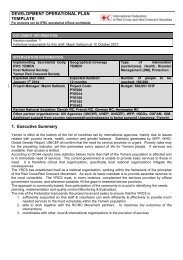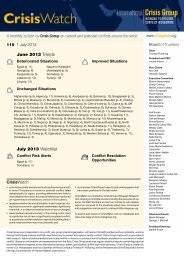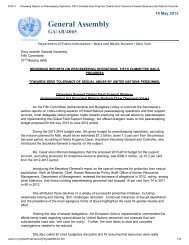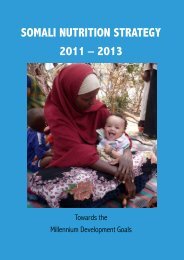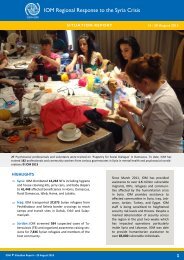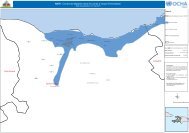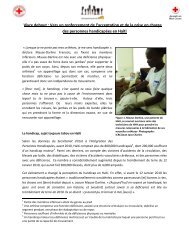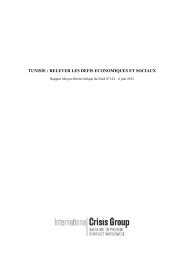issues for consideration at the berlin donor conference ... - ReliefWeb
issues for consideration at the berlin donor conference ... - ReliefWeb
issues for consideration at the berlin donor conference ... - ReliefWeb
You also want an ePaper? Increase the reach of your titles
YUMPU automatically turns print PDFs into web optimized ePapers that Google loves.
2 THE ROAD AHEAD<br />
PILLAR I OF THE AFGHAN NATIONAL DEVELOPMENT FRAMEWORK:<br />
EXPANDING SOCIAL AND HUMAN CAPITAL<br />
The Afghan government has identified expanding social and human capital as <strong>the</strong> first pillar of <strong>the</strong><br />
NDF with <strong>the</strong> goal of facilit<strong>at</strong>ing not only basic survival, but of enabling <strong>the</strong> Afghan people to<br />
become productive and contributing members of society. The Afghan government is requesting<br />
$6.9 billion in <strong>donor</strong> support <strong>for</strong> this pillar, which covers five priority programs: health, educ<strong>at</strong>ion,<br />
returnee reintegr<strong>at</strong>ion, livelihoods, and culture, media and sport. This report will examine <strong>the</strong> first<br />
three.<br />
HEALTH<br />
St<strong>at</strong>us Report<br />
Two years after <strong>the</strong> start of massive intern<strong>at</strong>ional humanitarian relief ef<strong>for</strong>ts in December 2001, <strong>the</strong><br />
majority of <strong>the</strong> Afghan popul<strong>at</strong>ion still lacks reliable access to health care. Children and women<br />
suffer most acutely from this deficiency.<br />
• Childbirth is particularly risky in Afghanistan, with approxim<strong>at</strong>ely 165 infants and 16 women<br />
dying <strong>for</strong> every 1,000 births. 6<br />
• Afghanistan’s infant mortality r<strong>at</strong>e is <strong>the</strong> highest in Asia and one of <strong>the</strong> highest in <strong>the</strong> world,<br />
and <strong>the</strong> m<strong>at</strong>ernal mortality r<strong>at</strong>e is <strong>the</strong> second highest in <strong>the</strong> world.<br />
• Poor pre-and post-n<strong>at</strong>al care means th<strong>at</strong> children who do survive infancy encounter serious<br />
health problems l<strong>at</strong>er in life.<br />
o 90 percent of women do not have access to pren<strong>at</strong>al care. 7<br />
o 70 percent of primary care clinics are unable to provide basic m<strong>at</strong>ernal and infant<br />
services. 8<br />
• One-quarter of Afghan children die be<strong>for</strong>e <strong>the</strong> age of five.<br />
• Forty percent of Afghanistan’s children die from preventable causes such as diarrhea, often<br />
caused by lack of access to sanit<strong>at</strong>ion and clean drinking w<strong>at</strong>er.<br />
• Chronic malnutrition is estim<strong>at</strong>ed to afflict between 45 and 59 percent of children.<br />
The Ministry of Public Health (MoPH) has cre<strong>at</strong>ed an overall framework <strong>for</strong> <strong>the</strong> country’s health<br />
sector. Its N<strong>at</strong>ional Health and Nutrition Program lays out <strong>the</strong> objective of “reducing <strong>the</strong> high<br />
levels of mortality and morbidity, especially among women and children, through <strong>the</strong> development<br />
of equitable, effective and efficient health services th<strong>at</strong> address priority health and nutrition<br />
problems, and by developing <strong>the</strong> capacity to deliver necessary services.” 9<br />
6 “M<strong>at</strong>ernal Mortality in Afghanistan: Magnitude, Causes, Risk Factors and Preventability,” Summary Findings of <strong>the</strong><br />
Afghan Ministry of Public Health and <strong>the</strong> Centers <strong>for</strong> Disease Control and Prevention, November 6, 2002,<br />
(accessed November 28, 2003).<br />
7 The World Bank, “AFGHANISTAN-Afghanistan Health Sector Emergency Rehabilit<strong>at</strong>ion,” InfoShop Initial Project<br />
In<strong>for</strong>m<strong>at</strong>ion Document (PID) No. AB12, April 2, 2003, <br />
(accessed December 12,<br />
2003).<br />
8 “Securing Afghanistan’s Future: Accomplishments and <strong>the</strong> Str<strong>at</strong>egic P<strong>at</strong>h Forward. Health and Nutrition Technical<br />
Annex,” Afghan Government/Intern<strong>at</strong>ional Agency Report, January 2004,<br />
(accessed February 15, 2004) [hereinafter “Health and Nutrition Technical Annex”].<br />
9 Health and Nutrition Technical Annex.




